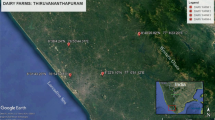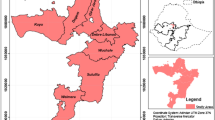Abstract
The study examined Pakistan’s livestock sector to assess the scale of GHG emissions and identified feasible technical interventions through which GHG particularly methane can potentially be reduced. Life Cycle Assessment of emissions from livestock production supply chain for the year 2014 was performed using Global Livestock Environment Assessment Model (GLEAM-i, version 2) developed by FAO. Annual emissions from the livestock sector were estimated at 404.2 million ton CO2 eq., representing carbon dioxide 6.6%, methane 70.6% and nitrous oxide 22.8%. Enteric methane averaged 63.4% of total emissions. Feed production and processing, manure management and energy use contributed 25%, 11% and 1%, respectively to the total sector emissions. Carbon footprint of milk from cows and buffalo was 184.9 against global average of 110.0 kg CO2-eq/kg milk protein and that of beef and mutton was 606.4 against the global average of 235 CO2-eq/kg meat protein. The emission intensity of chicken meat and eggs were lowest 49.6 and 20.8 kg CO2-eq/kg protein, respectively and compared to global averages. Buffaloes produced maximum GHG followed by cattle, goats, sheep and poultry. Mitigation interventions in the form of improved fodder, herd heath and genetics reduced methane intensity ranging from 14.6 to 43.2% compared to baseline. This was associated with 25–100% increase in milk yield and 10–65% in meat supply above baseline scenarios. The strong inverse correlation between methane intensity and milk yield suggested that efforts to enhance productivity reduce carbon footprint of the livestock products thus achieving the dual goals of protecting environment and food security.




Similar content being viewed by others
References
Alexandratos N and Bruinsma J (2012) World agriculture towards 2030/2050: the 2012 revision. Agricultural development economics division, Food and Agriculture Organization of the United Nations, Rome. http://large.stanford.edu/courses/2014/ph240/yuan2/docs/ap106e.pdf. Accessed 08 May 2018
Dost M (2003) Fodder production for peri-urban dairies in Pakistan. Country Pasture/Forage Resource Profiles, FAO, Rome. http://www.fao.org/ag/AGP/AGPC/doc/Counprof/Pakistan/Pakistan.htm. Accessed 02 May 2018
FAO (2009) The state of food and agriculture; livestock in balance food and agriculture organization of the united nations, Rome. http://www.fao.org/docrep/012/i0680e/i0680e.pdf. Accessed 19 Apr 2018
FAO (2010) Greenhouse Gas Emissions from the dairy sector; a life cycle assessment. Animal Production and Health Division. FAO, Rome. http://www.fao.org/docrep/012/k7930e/k7930e00.pdf. Accessed 10 Apr 2018
FAO (2013) Greenhouse gas emissions from ruminant supply chains—a global life cycle assessment. FAO, Rome. http://www.fao.org/docrep/018/i3461e/i3461e.pdf. Accessed 10 Apr 2018
FAO (2016) The state of food and agriculture; climate change, agriculture and food security. Food and Agriculture Organization of the United Nations, Rome. http://www.fao.org/3/a-i6030e.pdf. Accessed 05 May 2018
FAO (2017) Supporting low emissions development in the Ethiopian dairy cattle sector—reducing enteric methane for food security and livelihoods. FAO and New Zealand Agricultural Greenhouse Gas Research Centre Rome. http://www.fao.org/3/a-i6821e.pdf. Accessed 12 April 2018
Garg MR, Phondba BT, Sherasia PL, Makkar HPS (2016) Carbon footprint of milk production under smallholder dairying in Anand district of Western India: a cradle-to-farm gate life cycle assessment. Animal Prod Sci 56:423–436. https://doi.org/10.1071/AN15464
Gerber PJ, Steinfeld H, Henderson B, Mottet A, Opio C, Dijkman J, Falcucc, Tempio AG (2013a) Tackling climate change through livestock- a global assessment of emissions and mitigation opportunities. FAO, Rome. http://www.fao.org/3/a-i3437e.pdf. Accessed 09 Apr 2018
GLEAM-i (2016) Global livestock environmental assessment model, version 1. FAO, Rome. http://www.fao.org/gleam/resources/en/. Accessed 02 Oct 2017
GOP (1996) Livestock Census Pakistan, Agricultural Census Organization,Statistical Division, Government od Pakistan, Gulberg Lahore, Pakistan
GOP (2006) Livestock census Pakistan, Government of Pakistan, Statistical division, Islamabad, Pakistan. http://www.pbs.gov.pk/content/pakistan-livestock-census-2006. Acceessed 04 May 2017
GOP (2014-15) Economic survey of pakistan. Government of Pakistan, Statistical division, Islamabad, Pakistan. http://www.finance.gov.pk/survey/chapters_15/02_Agricultre.pdf. Accessed 04 May 2017
GRA (2016) Livestock development and climate change: the benefits of advanced greenhouse gas inventories. https://cgspace.cgiar.org/rest/bitstreams/81212/retrieve. Accessed 24 May 2018
Habib G, Fatah Ullah KM, Javaid S, and Saleem M (2016) Assessment of feed supply and demand for livestock in Pakistan. J Agric Res Technol, A 6: 191–202 http://www.davidpublisher.org/Public/uploads/Contribute/585744deb7133.pdf. Accessed 20 Nov 2017
Hristov AN, Oh J, Firkins JL, Dijkstra J, Kebreab E, Waghorn G, Makkar HPS, Adesogan TT, Yang W, Lee C, Gerber PJ, Henderson B,Tricarico JM (2013) Special topics: mitigation of methane and nitrous oxide emissions from animal operations: I. A review of enteric methane mitigation options. J Anim Sci 91:5045–5069. https://doi.org/10.2527/jas2013-6583
IPCC (1997) In: Houghton J.T, Meira Filho L.G, Lim B, Treanton K, Mamaty I, Bonduki Y, Griggs D.J, Callander B.A (eds) Revised 1996 IPCC guidelines for national greenhouse gas inventories. Intergovernmental panel on climate change, IPCC/OECD/IEA, Paris, France
IPCC (2014a) Climate change 2014: synthesis report. Contribution of working groups I, II and III to the fifth assessment report of the intergovernmental panel on climate change [Core Writing Team, R.K. Pachauri and L.A. Meyer (eds.)]. IPCC, Geneva, Switzerland, p 151
IPCC (2014b) Climate change 2014: impacts, adaptation, and vulnerability. Part B: regional aspects. Contribution of working group II to the fifth assessment report of the intergovernmental panel on climate change. In: Barros VR, Field CB, Dokken DJ Mastrandrea MD, Mach KJ, Bilir TE, Chatterjee M, Ebi KL, Estrada YO, Genova RC, Girma B, Kissel ES, Levy AN, MacCracken S, Mastrandrea PR, White LL (eds) Cambridge University Press, Cambridge, United Kingdom and New York, NY, USA, p 1132
Jabbar MA and Ahuja V (2017) Dairy and climate change interface with a focus on the Asia-Pacific region: an exploratory review. working paper number: 2017-05, FAO Regional office for Asia and the Pacific, Bangkok, Thailand. http://www.dairyasia.org/file/WP5_Dairy_and_climate_change_interface.pdf. Accessed 20 Jan 2018
Kaleem AM and Ijaz M (2016) Greenhouse gas emission inventory of Pakistan for the year 2011–2012, GCISC Research Report-RR-19, Global Change Impact Studies Centre (GCISC) Ministry of Climate Change, Islamabad, Pakistan
Kebebe EG, Oosting SJ, Baltenweck I, Duncan AJ (2017) Characterization of adopters and non-adopters of dairy technologies in Ethiopia and Kenya. Trop Anim Health Prod 49(4):681–690. https://doi.org/10.1007/s11250-017-1241-8
Knapp JR, Laur GL, Vadas PA, Weiss WP, Tricarico JM (2014) Enteric methane in dairy cattle production: quantifying the opportunities and impact of reducing emissions- invited review. J Dairy Sci 97(6):3231–3261. https://doi.org/10.3168/jds.2013-7234
Opio C (2017) Feeding strategies to reduce methane and improve livestock productivity. Feedipedia, FAO, Rome. https://www.feedipedia.org/sites/default/files/public/BH_039_methane_productivity.pdf. Accessed 9 Apr 2018
Opio C, Gerber P, Mottet A, Falcucci A, Tempio G, MacLeod M, Vellinga T, Henderson B, Steinfeld H (2013) Greenhouse gas emissions from ruminant supply chains—a global life cycle assessment. Food and Agriculture Organization of the United Nations (FAO), Rome. http://www.fao.org/docrep/018/i3461e/i3461e.pdf. Accessed 9 Apr 2018
Pryce JE, Veerkamp RF (2010) The incorporation of fertility indices in genetic improvement programmes. Fertility in the high producing dairy cow. BSAS Occ Publ 26:237–250. https://www.researchgate.net/publication/40147506. Accessed 10 Apr 2018
Tubiello FN, Salvatore M, Rossi S, Ferrara A, Fitton N, Smith P (2013) The FAOSTAT database of greenhouse gas emissions from agriculture. Environ. Res. Lett. 8:015009. https://doi.org/10.1088/1748-9326/8/1/015009
Wolf J, Asrar GR, Tristram O, West TO (2017) Revised methane emissions factors and spatially distributed annual carbon fluxes for global livestock. Carbon Balance Manage 12:16. https://doi.org/10.1186/s13021-017-0084-y
Author information
Authors and Affiliations
Corresponding author
Ethics declarations
Conflict of interest
On behalf of all authors, the corresponding author states that there is no conflict of interest.
Rights and permissions
About this article
Cite this article
Habib, G., Khan, A.A. Assessment and Mitigation of Methane Emissions from Livestock Sector in Pakistan. Earth Syst Environ 2, 601–608 (2018). https://doi.org/10.1007/s41748-018-0076-4
Received:
Accepted:
Published:
Issue Date:
DOI: https://doi.org/10.1007/s41748-018-0076-4




